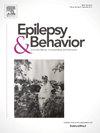在凯尼酸颞叶癫痫动物模型中进行细菌脂多糖后调节。
IF 2.3
3区 医学
Q2 BEHAVIORAL SCIENCES
引用次数: 0
摘要
本研究采用向 Wistar 大鼠海马内注射凯尼克酸(KA)的方法,诱导经过 9 天潜伏期的自发性复发性癫痫发作(SRS)。在最初的 KA 损伤 72 小时后,在同一部位注射 LPS 进行后条件处理,以触发继发性竞争过程。为了评估 LPS 的后调节效应,25 只动物被分为四组:SAL-SAL组(n = 6)、KA-SAL组(n = 6)、SAL-LPS组(n = 7)和KA-LPS组(n = 6)。从第9天到第17天,通过视频监测对SRS发生率和发作持续时间以及其他发作行为(如追尾和湿狗摇等)进行量化。行为评估显示,与KA-SAL组相比,KA-LPS组在物体识别测试中保留了蔗糖偏好和完整的长期记忆,表明抑郁样行为减少,认知能力得到保护。强迫游泳测试显示,SAL-LPS 组的抑郁样行为增加,而 LPS 可减轻 KA 组的这些影响。大理石掩埋测试显示各组间无显著差异。动物在第 26 天被安乐死,海马切片用荧光玉染色法分析细胞死亡,用免疫荧光染色法分析 Iba-1(小胶质细胞)和 GFAP(星形胶质细胞)标记。研究结果支持以下假设:癫痫的发生涉及神经网络的一连串可塑性变化,而精确、及时的干预措施有可能干扰这一过程。本文章由计算机程序翻译,如有差异,请以英文原文为准。
Bacterial Lipopolysaccharide Post-Conditioning in The kainic acid animal model of Temporal Lobe epilepsy
This study used intra-hippocampal injections of Kainic Acid (KA) in Wistar rats to induce spontaneous recurrent seizures (SRS) after a 9-day latent period. A post-conditioning protocol with LPS, injected at the same site 72 h after the initial KA insult, was employed to trigger secondary competing processes. To evaluate the post-conditioning effect of LPS, 25 animals were divided into four groups: SAL-SAL (n = 6), KA-SAL (n = 6), SAL-LPS (n = 7), and KA-LPS (n = 6). SRS occurrence and seizure duration were quantified through video monitoring from days 9 to 17, along with other ictal behaviors, such as tail-chasing and wet-dog-shakes. Behavioral assessments revealed that the KA-LPS group had preserved sucrose preference and intact long-term memory in the object recognition test, indicating reduced depressive-like behavior and cognitive preservation compared to the KA-SAL group. The forced swim test showed increased depressive-like behavior in the SAL-LPS group, with LPS mitigating these effects in the KA group. The marble-burying test showed no significant differences among groups. Animals were euthanized on day 26, and hippocampal slices were analyzed using fluoro-jade staining for cell death and immunofluorescence staining for Iba-1 (microglia) and GFAP (astrocyte) labeling. The results support the hypothesis that epileptogenesis involves a cascade of plastic changes in neural networks and that precise, timely interventions can potentially interfere with this process.
求助全文
通过发布文献求助,成功后即可免费获取论文全文。
去求助
来源期刊

Epilepsy & Behavior
医学-行为科学
CiteScore
5.40
自引率
15.40%
发文量
385
审稿时长
43 days
期刊介绍:
Epilepsy & Behavior is the fastest-growing international journal uniquely devoted to the rapid dissemination of the most current information available on the behavioral aspects of seizures and epilepsy.
Epilepsy & Behavior presents original peer-reviewed articles based on laboratory and clinical research. Topics are drawn from a variety of fields, including clinical neurology, neurosurgery, neuropsychiatry, neuropsychology, neurophysiology, neuropharmacology, and neuroimaging.
From September 2012 Epilepsy & Behavior stopped accepting Case Reports for publication in the journal. From this date authors who submit to Epilepsy & Behavior will be offered a transfer or asked to resubmit their Case Reports to its new sister journal, Epilepsy & Behavior Case Reports.
 求助内容:
求助内容: 应助结果提醒方式:
应助结果提醒方式:


